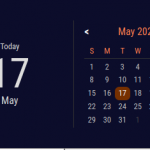| Author: | dgtlss |
|---|---|
| Views Total: | 0 views |
| Official Page: | Go to website |
| Last Update: | November 10, 2024 |
| License: | MIT |
Preview:

Description:
Chronos is a lightweight and fast date & time parsing, manipulating, and formatting JavaScript library ideal for web developers handling complex date-related tasks.
It can be useful for a variety of applications, like scheduling, calendars, data visualization, and even just displaying the current date and time on a website.
Key Features:
- Intuitive API: Simple and easy-to-use methods for common date/time operations.
- Parsing & Formatting: Flexible date parsing and customizable output formats.
- Time Zone Support: Handles different time zones accurately.
- Date Arithmetic: Easily add and subtract time units.
- Date Comparison: Compare dates with various methods.
- Utility Functions: Helpful methods for common date checks (weekdays, weekends, etc.).
- Advanced Features: Duration calculation, human-readable differences, business day calculations.
- Static Methods: Convenient methods for creating and parsing dates.
How to use it:
1. Download and load the minified version of the Chronos library in the document.
<script src="chronos.min.js"></script>
2. Create a date object using multiple formats:
// Current Date and Time:
const now = new Chronos();
// From a Date String
const date = new Chronos('2024-11-10T21:30:00Z');
// From a Timestamp
const timestamp = new Chronos(1731294338);
// With a Specific Time Zone
const ukDate = new Chronos('2024-11-10T21:30:00Z', 'Europe/London');3. Extract date information from a date object.
const date = new Chronos('2024-11-10T21:30:00Z');
// 2024
date.year();
// 11
date.month();
// 10
date.date();
// 1 = Monday
// 0 = Sunday
date.day();
// 21
date.hours();
// 30
date.minutes();
// 00
date.seconds();
// 00
date.milliseconds();
// 1731274200
date.timestamp();4. Add or subtract time using add(value, unit) and subtract(value, unit). Units include ‘years’, ‘months’, ‘weeks’, ‘days’, ‘hours’, ‘minutes’, and ‘seconds’.
const date = new Chronos('2024-11-10T21:30:00Z');
// 11-10-2024
date.add(1, 'day').format('MM-DD-YYYY'));
// 11-10-2024 20:30
date.subtract(1, 'hours').format('MM-DD-YYYY HH:mm'));5. Format the date with format(formatString). Tokens like YYYY, MM, DD, HH, mm, ss define the format. See the examples in Step 4.
6. Compare dates using methods like isBefore(other), isAfter(other), isSame(other), isBetween(start, end), and more granular checks like isSameDay(other). Returns true or false.
const date1 = new Chronos('2024-11-10T21:30:00Z');
const date2 = new Chronos('2024-11-11T21:30:00Z');
date1.isBefore(date2);
date1.isAfter(date2);
date1.isSame(date2);
date1.isBetween(start, end);
date1.isSameDay(date2);
date1.isSameMonth(date2);
date1.isSameYear(date2);7. Check if a date is a weekday (isWeekday()), weekend (isWeekend()), today (isToday()), in the future (isFuture()), and other helpful functions. Returns true or false.
const date = new Chronos('2024-11-10T21:30:00Z');
date.isWeekday();
date.isWeekend();
date.isToday();
date.isTomorrow();
date.isYesterday();
date.isFuture();
date.isPast();
date.isLeapYear();
date.quarter();8. Convert date objects into various formats.
const date = new Chronos('2024-11-10T21:30:00Z');
date.toDate(); // JS Date object
date.valueOf(); // timestamp in milliseconds
date.toString(); // ISO string
date.toJSON();
date.toArray();
date.toObject();9. Calculate differences between dates in a human-readable format, get durations, add business days, and work with start and end times of time units.
const date1 = new Chronos('2024-11-10T21:30:00Z');
const date2 = new Chronos('2024-11-11T21:30:00Z');
// 1 days ago
date1.diffForHumans(date2, options)
// { days: 1, hours: 0, minutes: 0, seconds: 0 }
date1.duration(date2)
date1.addBusinessDays(days);
// Unit: year, month, day, hour
date1.startOf(unit);
date1.endOf(unit);10. Chronos also offers static methods like Chronos.now(), Chronos.parse(), and others for creating and parsing dates directly from the Chronos class.
Chronos.now(timezone); Chronos.parse(input, timezone); Chronos.createFromFormat(format, dateString); Chronos.createFromTimestamp(timestamp); Chronos.createFromTimestampMs(timestampMs); Chronos.generateCalendar(year, month);










